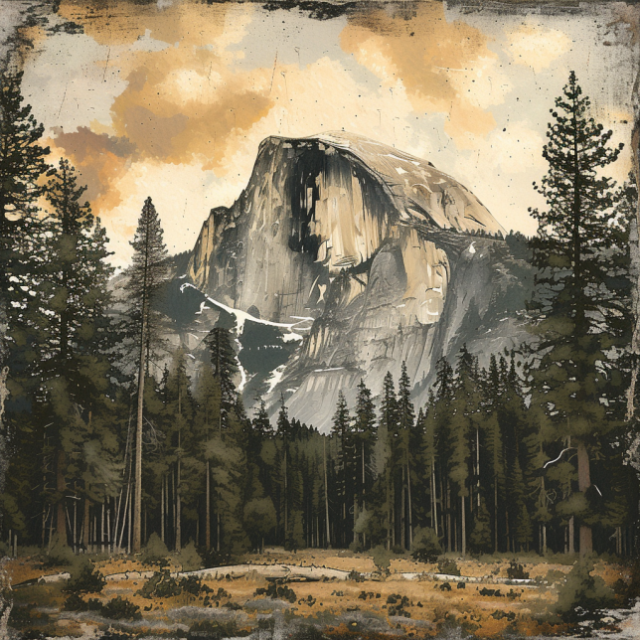In the annals of climbing history, few stories capture the spirit of adventure and human determination as vividly as George G. Anderson’s first ascent of Half Dome in Yosemite National Park. This feat, achieved in 1875, was not merely a physical conquest of one of nature’s most formidable monoliths but also a testament to the indomitable will of a man who dared to tread where no one had before.

George G. Anderson, a blacksmith by profession, ventured into the realm of mountaineering driven by a blend of curiosity and audacity. His background was far removed from the elite circles of climbers who, at the time, were beginning to test their mettle against the mountains of the world. Yet, it was Anderson’s humble origins and his trade that equipped him with a unique set of skills and a perspective that would redefine what was considered possible in the world of climbing.
The story of Anderson’s ascent begins in the scenic valleys of Yosemite, a place of awe-inspiring beauty and natural wonders, where the granite giant known as Half Dome looms large. To many, this towering formation was more than just a mountain; it was a symbol of the unattainable, a challenge that beckoned yet seemed beyond reach. Its sheer, smooth face presented a formidable barrier that had repelled all who had dared to conquer it. But to Anderson, Half Dome represented an irresistible call to adventure, a puzzle that demanded a solution.
Anderson’s preparation for the climb was unconventional. eschewing traditional climbing gear or techniques, he instead relied on the tools of his trade—hammer, drill, and iron bolts. His plan was as straightforward as it was audacious: to drill a series of holes into the granite, inserting eye bolts to create a makeshift ladder to the summit. This approach, while unorthodox, was a reflection of Anderson’s pragmatic problem-solving mindset and his unwavering belief in the power of human ingenuity.
The climb commenced in the early hours of a crisp autumn morning, as Anderson set out alone to face the mountain. The task ahead was daunting; the granite surface of Half Dome was unforgiving, offering little in the way of natural handholds or footholds. Yet, with each strike of his hammer and twist of his drill, Anderson made slow but steady progress, carving a path upwards through sheer force of will.
As he ascended, Anderson was confronted with the physical and mental challenges that accompany such a perilous endeavor. The physical strain was immense, each movement requiring a careful balance of strength and precision. Mentally, the isolation and exposure tested his resolve, as the ground receded and the summit loomed ever closer. Yet, amid these challenges, Anderson found a profound connection with the mountain and the natural world around him. The climb became more than a physical journey; it was a spiritual quest, a communion with the earth itself.
As George G. Anderson made his way up the imposing face of Half Dome, each placement of an iron bolt was a step into the unknown, a forging of a new path where none existed. His journey was solitary, a dialogue between man and granite that unfolded with each hammer strike against the cold, unyielding surface. This was a venture where failure held dire consequences, not just for Anderson but for the very notion of human limits and our relationship with the natural world.
The ascent challenged Anderson in ways he could never have anticipated. The sheer physical toll of hammering bolts into granite, the mental strain of solitude, and the ever-present danger of a misstep that could end his endeavor—or worse, his life—were constant companions. Yet, Anderson’s resolve never wavered. With each step, he not only climbed higher on the mountain but also deeper into his own reserves of strength and determination.
Anderson’s innovative approach to climbing Half Dome was reflective of a broader ethos that characterized the era: a belief in progress, in the ability of human ingenuity to overcome natural barriers. The late 19th century was a time of rapid technological advancement and exploration, and in many ways, Anderson’s climb was emblematic of this spirit of exploration and conquest. However, unlike the industrial exploits that often sought to dominate nature, Anderson’s endeavor was one of partnership with the natural world. He sought not to conquer Half Dome but to engage with it, to find a way that respected its grandeur while fulfilling his quest.
Upon reaching the summit, Anderson’s first act was not one of triumphalism but of reflection. The view from atop Half Dome offered a panorama of Yosemite’s majestic landscape, a vista of valleys, mountains, and skies that spoke to the profound beauty and power of nature. For Anderson, this moment was the culmination of more than just a physical journey; it was the realization of a dream that had seemed as insurmountable as the granite face he had ascended.
The legacy of George G. Anderson’s ascent of Half Dome extends far beyond the personal achievement of one man. It marked a moment in the history of climbing that would inspire generations of climbers and adventurers to pursue their dreams, no matter how impossible they might seem. Anderson had demonstrated that with determination, innovation, and respect for nature, even the loftiest goals could be attained.
Moreover, Anderson’s climb highlighted the importance of Yosemite as a natural wonder and contributed to the growing movement for the conservation of America’s wild places. The awe-inspiring beauty of Yosemite, underscored by Anderson’s remarkable feat, would become central to the efforts to preserve these landscapes for future generations.
In the end, the story of George G. Anderson and his ascent of Half Dome is one of human perseverance, of a man who looked at the sky and decided to climb towards it. It is a narrative that resonates with all who seek to explore, to push beyond the boundaries of what is known, and to find in nature not an adversary but a companion in the quest for the extraordinary.
